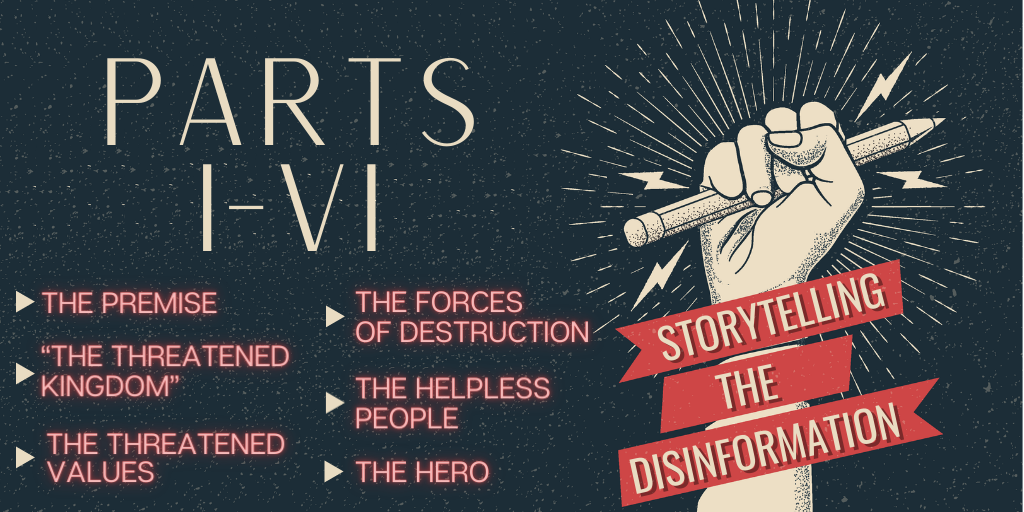
Once upon a Time, in a kingdom far, far away, a dragon was keeping the entire population hostage, poisoning it with its toxic breath. The people of the kingdom forgot everything that was important: values, decency, memories of the past. The dragon made people believe they were happy. A valiant prince did not succumb to the dragon; his people were immune against the dragon’s venomous exhalations. And while the dragon and his minions repeatedly attempted to defeat the prince, he managed to defend himself and lead the charge to liberate the people of the kingdom, far, far away.
Disinformation is a form of storytelling. The challenge for a liar is to make the lie attractive and plausible, to make it engage the intended audience. Most of the pro-Kremlin disinformation boils down to a small number of narratives, plots with a strong similarity to the fairy tale above.
Part 1. The Premise
Stories instead of Facts
The American researcher Walter Fisher[1] suggested that stories are more persuasive than facts.
The concept of storytelling starts with the notion that people generally believe stories rather than facts. We chose to smoke because we like the story of smoking, the way it looks etc, while we successfully ignore facts about the consequences of smoking. Male bosses wear ties not because it is practical or factually useful, but because it narrates a story about importance, power, etc. Kremlin disinformation tells a story to the audience about a society in peril, corrupt politicians and valiant Russia – an attractive story that resonates with a large part of the audience. Just like Cinderella or the legend of St. George.
Kremlin disinformation is founded entirely on storytelling. The EUvsDisinfo has collected, to date, just under 9,000 cases of false claims, all narrated in more or less the same way and suggesting destructive forces work for an imminent collapse of society as we know it.
Some researchers suggest there are very few ways of actually telling a story. The British author Christopher Booker identifies seven basic plots[2]. Obviously a story can include several parallel plot-lines, but in general – the basic outline of the plots is the same. The story about the Prince who saves the Maiden from the Dragon is virtually the same as the Kremlin version of the Victory over Nazism: the Good defeats the Evil and saves the Helpless. Russia (the valiant Prince) defeats Nazism (the evil Dragon) and saves Europe (the helpless victim).
The roles are the same if we look at how the coronavirus pandemic occasionally was narrated: Russia (the Prince) challenged the coronavirus and selfish neighbours (the evil Dragons) and saved Italy (the helpless victim). The basic structure of the story can easily be changed, certain elements can be emphasised, the story can be more or less complicated, but eventually the narrative remains the same. Any conflict, crisis or situation can easily be narrated along the same line. The narrative functions as a template, making production easy and the story attractive and engaging.
Once Upon a Time
The basic narrative of the pro-Kremlin disinformation starts in a simple premise, surprisingly similar to anything we read in the fairy-tales:
Destructive forces controlling the government, money flows and the media threaten the natural order and values of the World. The forces of destruction have subdued the people, Russia has been attacked at several times and brought almost to a point of obliteration. Wise and strong leaders have always managed to make Russia rise again and fight back. Now Russia is mankind’s last hope of order and decency, a bastion of Christian values and stability.
Of course, disinformation is not about fairy tales. The concept of story-telling is a way to describe how disinformation works, how it is narrated. The premise functions as a template for writers, pundits and, of course, politicians and spin doctors, to communicate lies in a way that attracts a selected audience. Different elements of the premise can be emphasised to target a domestic audience or an international one, for addressing an audience with leftist sympathies or right-wing supporters.
In coming weeks, we will look closer into the Kremlin’s fairy-tales. The roles are already defined: The Good Guy, The Forces of Evil, The Passive Victim. The battlegrounds is the Collapsing Society, with Threatened Values as the apple of discord.
[1] https://arnevanbatenburg.com/filmmaking/storytelling/storytelling-narrative-paradigm/
[2] https://onlyagame.typepad.com/only_a_game/2005/10/the_seven_basic.html
Part 2. “The Threatened Kingdom”
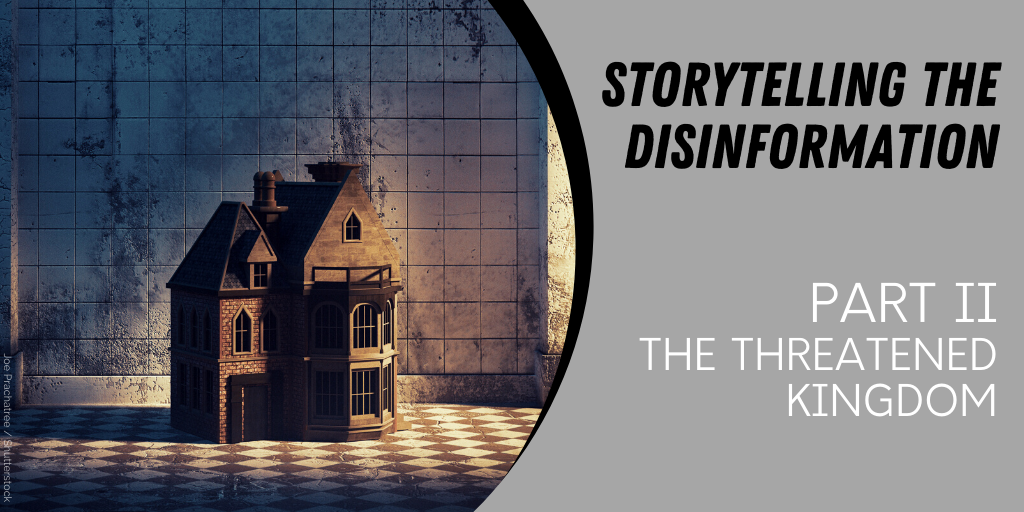
The Imminent Collapse
A crisis, when narrated by pro-Kremlin disinformation outlets, always has an element of apocalypse in it. The migration crisis, unemployment, the coronavirus pandemic, a NATO military exercise – all fit in to a narrative of an imminent collapse.
Any society regularly faces challenges. A recent example is the COVID-19 outbreak – a crisis neither the European Union, nor its member states, Russia, China, international bodies, nor anyone else was prepared for. The outbreak took the world by surprise, and it is obvious that most actors, national and international, could have acted better, more efficiently. Could the EU have handled the crisis differently? Is the criticism of the EU justified? Certainly.
In pro-Kremlin disinformation outlets, the COVID-19 outbreak has been described as the end of Schengen, the fall of the European Union, the crash of the Liberal ideology, of the Globalist project, of the concept of Democracy. Democracies are, according to Russia’s national broadcaster Channel One, unable to combat the pandemic.
The migration crisis 2015 – 2016 did also, without a doubt, constitute a serious challenge to the EU and its member states. Already finding shelter and protection for hundreds of thousands of refugees was complicated. The pro-Kremlin media described the situation as a total collapse; maybe even the beginning of a war.
A Kingdom, far, far away
Occasionally, the fairy-tale dramaturgy is very much visible, as in this article from Russia’s largest daily, the Komsomolskaya Pravda, describing the “the Kingdom, far, far away” has become a crime-infested wasteland.
Darya Aslamova, Komsomolskaya Pravda’s correspondent, has visited a Scandinavian country and seen the horror: a European country always known as a symbol of calm and progress, has subjected itself placidly into the paws of Islamic migrants, forcing their savage habits on it.
This premise does not, of course, have anything to do with anything in the real world, but it works very well to storytell the claim of a societal collapse in Europe, in this case – Sweden. Social issues, present in most countries, are presented as proof of a state that has ceased to function. The story is appealing. The Komsomolskaya Pravda – Russia’s largest daily and among the 20 largest in Europe – has its audience in Russia. The story about a Europe in decay and chaos is soothing for a reader in Russia: “At least we don’t have it that bad!”.
The COVID-19 outbreak is used in a similar fashion: it proves that the unviability of the democratic, open society. Several cases in the EUvsDisinfo Disinformation Database suggest an imminent, ongoing or completed collapse of EU and its institutions. There is no doubt that the pandemic has caused tragedy, suffering among European citizens, and the crisis exposed weaknesses in the EU crisis response system. However, the citizens and institutions have responded in transparency and solidarity in a matter of days.
Creating an image of a society in flames, crime out of control, and incompetent politicians is an efficient way of creating rapport to the audience. Disinformation outlets hand out consistent stories and offer easy answers – do not trust your elected authorities and institutions; instead – look for inspiration at powerful aged leaders, able to take care single-handedly of your security and prosperity The stories stoke fears – horrors are always somewhere else, but might very soon spread to our own neighbourhood. Unless of course you join the protest side.
Part 3. The Threatened Values
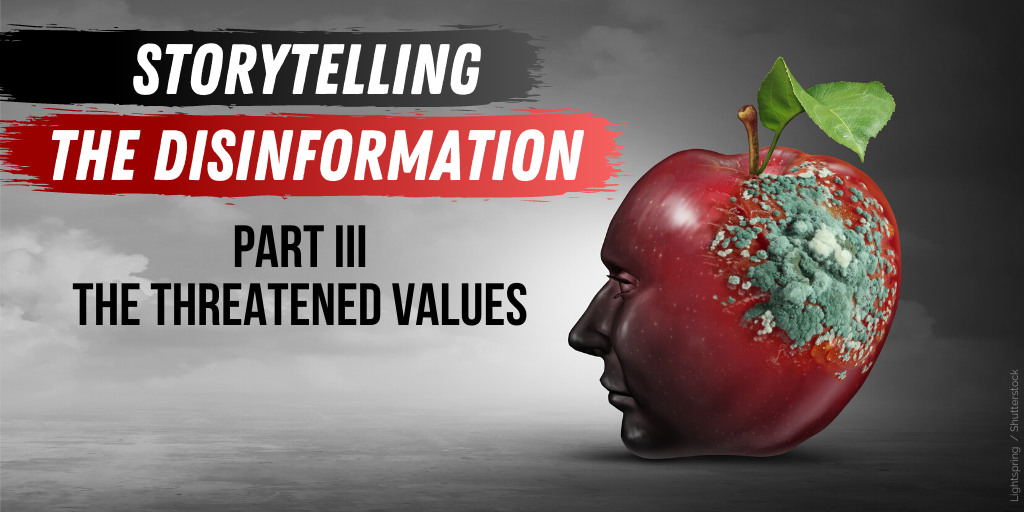
Moscow as a modern Sparta
The pro-Kremlin media often refer to the concept of “spirituality”. The western society has lost its connection with the real values and deferred entirely into decadence and consumerism. The West has abandoned the ideals of Christianity, Family and Patriotism – the true European values. One Russian nationalist philosopher, Aleksandr Dugin, suggests we are in the middle of a cosmic battle between two civilisations. Russia, Sparta and Rome represent mankind’s heroic nature, while the United States, Carthagene and Athens are examples of a civilisation, based on Liberalism, perversion and infanticide.
The Civilisation of the Seas, Carthagena, prayed to Baal and Moloch and was a cult based on money and sacrificing infants. It was the religion of the free markets and the financial oligarchs, of perversion, and corruption. It was a role model of the modern West; and one of the earliest versions of liberalism and globalism within the framework of the Mediterranean Sea. The civilisation of the Land, Rome, worshipped manly gods, glory and loyalty, respected the traditions and maintained a strictly conservative order.
The publicly available EUvsDisinfo Disinformation database is full of cases, where various pro-Kremlin outlets repeat, maybe less eloquently, Dugin’s thesis. The West represents decay, decadence and destruction. Militant feminists have crushed the Western man. Russian state media paints a grim picture of the future of the male gender:
The feminists have prevailed completely and irreversibly. The feminists are able to destroy any man who has the guts to take pride in his manhood– currently a questionable achievement. The logics of the evolution is out of order, the role of the man for humankind is reduced to a symbolic function. He has lost his privilege to prey; and has the same level of knowledge as everybody else. Only a person with mental issues go to war nowadays, and valiant duels are just silly and an option only among even-toed ungulates.
Genetics will remove man’s last remaining gift of nature: the right to spread his semen. For a while, men will imitate significance, but in reality, he has become a burden to society. One might, from a humane perspective, protect a few men. Let them live in designated areas, like Marco Polo sheep. In a few hundred years, amazons will fly in with helicopters for poaching.
European Values
On the other hand, Russia is a haven of order and decency – of true, European values:
The European Union has replaced the ancient, thousands of years old fundaments of Europe with a cocktail of liberalism, feminism, LGTB-activism – and an anti-European “anti-colonial” leftist rhetoric
[—]
Traditionalists, identitarians and eurosceptics look at Russia with hope, and at Putin as almost a Messiah. It is Moscow, rather than Paris, who is defending the values of European traditions and the high level of European culture. It is Russia that is the champion of the geopolitical pluralism that makes Europe the real Europe.
A concept used in Russian nationalist circles is that Russia is “The Katehon” – “The One Who Withholds”. This refers to a word from St. Paul’s epistles about a force that withholds the Antichrist. In the Kremlin’s story, this is the role of Russia; it’s civilizational duty.
Part 4. The Forces of Destruction
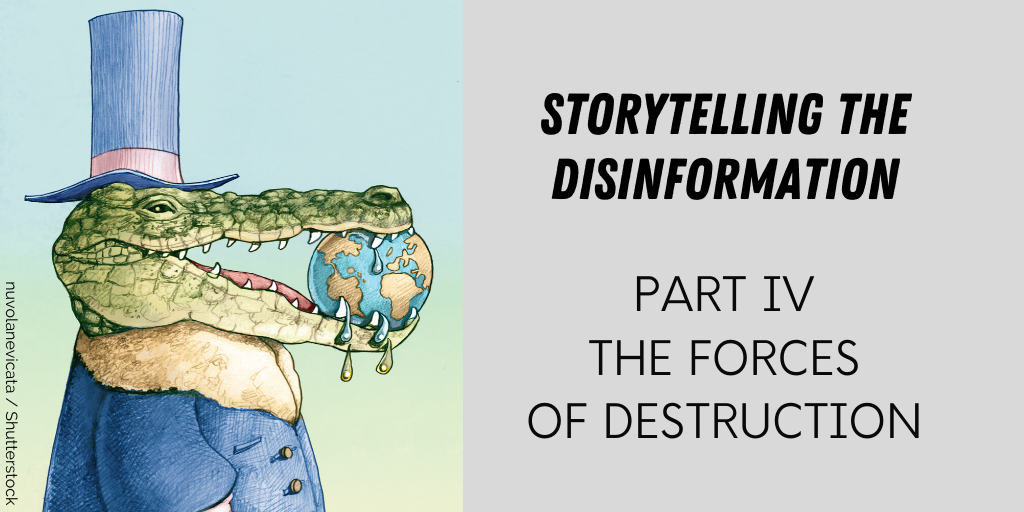
The Evil Dragon
The first case in the EUvsDisinfo Disinformation Database on the coronavirus, 22 January 2020, already painted a clear picture: the virus was manufactured in NATO laboratories. NATO is the villain in more than 10 percent of all cases in the database, paying Belarusian opposition to spread the virus, massing up military on Russia’s borders, preparing for an invasion, performing tests on humans… NATO is a threat to the countries’ sovereignty, it transforms member states into vassals of the United States.
NATO is a well-known bogeyman, a comfortable “dragon” for the Kremlin story. Generations of former Soviet citizens grew up during the Cold War and are familiar with this story.
Pro-Kremlin disinformation outlets eagerly employ conspiracy theories to back their narratives. When you can’t use existing parties as villains in a conspiracy, fantasy villains work just as well. One very popular villain is The Deep State.
The concept of The Deep State implies an existence of rulers behind the scenes. We might elect presidents and parliamentarians, but the real power lies somewhere else; in the bureaucracy, in the military, with the bankers and industrialists. There are, according to the pro-Kremlin media, secret, global elites that rule in the shadows. The EUvsDisinfo has written about the conspiracy theory as a comfortable instrument for disinformation.
The Shadow Rulers
The great thing with a conspiracy theory is that it can be reused with suitable villains to reach various audiences. The Vatican, The Liberals, The Rothschilds, George Soros, The British Empire, The Zionists… these are a few of the Dragons in the Kremlin fairy tale. Any kind of dissent in Russia is described as tools of malign forces abroad.
Occasionally, pro-Kremlin outlets descends into anti-Semitism. One notable offender is the US-based Russia Insider website. The site launched a full-fledged anti-Semitic campaign in January 2018 and has since become a vocal voice for white supremacy in the United States, praising Hitler and Putin with similar passion. Anti-Semitic content can also be found in Russian state-owned and/or oligarch controlled media. Russia’s largest daily, the Komsomolskaya Pravda, refers to the “Protocols of the Elders of Zion” in a comment to Donald Trump’s victory in the election 2016:
The shadow rulers of the world, the Elders of Zion or what we should call them, do not have any fail-safe method to win the power. They might write whatever they want in their papers, but who believes these papers anymore? The election of Trump proves that the people has lost its belief in the lying papers. The people decided by themselves. And the shadow rulers were left high and dry.
The Kremlin has an entire menagerie of dragons at its disposal. Fire-breathing, ominous and enigmatic, and always ready to look scary whenever a villain is needed.
Part 5. The helpless People
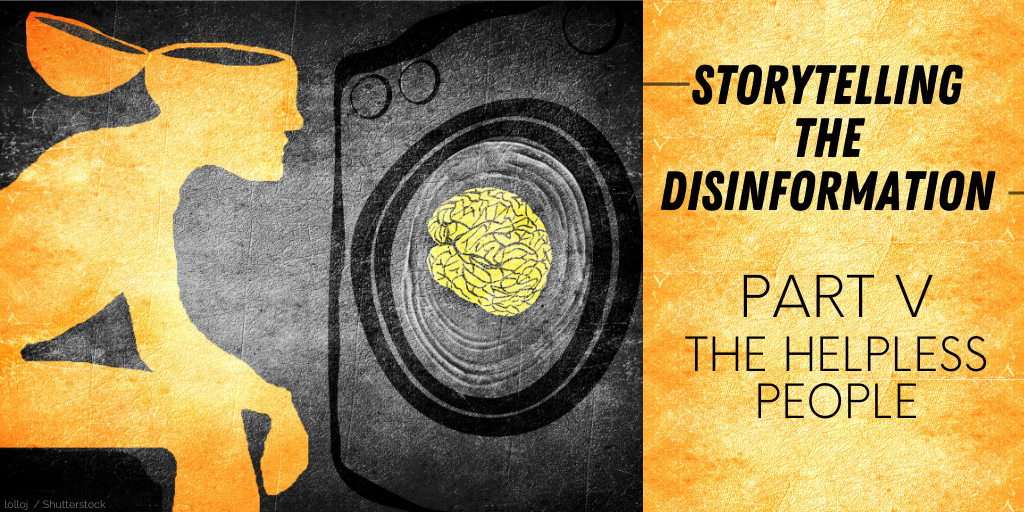
The Passive People
In the Kremlin’s worldview, the people are a passive mass in need of guidance. Expressions of popular discontent are never genuine; they are always provoked, staged and managed by outside forces bent on destruction. Euromaidan in Ukraine, the protests in Venezuela and in Hong Kong or even the Black Lives Matter protests in the United States – all are nothing but manifestations of destructive technologies:
It is not surprising that Trump is blamed for the death of Floyd, despite the fact that Minneapolis and Minnesota are run by Democrats. He was also blamed for the coronavirus by the Democrats, the same people who insisted for years that Russiagate was real. Now they blame Trump for responding to the riots (what they call “peaceful protests”) by sending the army. Colour revolutions follow a script: find a legitimate cause, ask the police and the army to join the protests, and if they don’t, intensify the riots to provoke a forceful response that creates martyrs. Everything useful must be captured by cameras, and any inconvenience removed from memory. The goal is not reform, equity or justice, but regime change.
Individual rights are a cornerstone of democracy. We make our own choices based on our personal convictions. The Kremlin’s view on democracy is fundamentally different. Russia’s president, Vladimir Putin, expressed in an article his conception of democracy:
We need to build a mechanism for a political system in a way that allows it to adopt and mirror the interests of the big social groups and secure a public concord on those interests.
According to this view, the party system should reflect the interests of social groups, not individuals. There should be, following the Kremlin’s logic, a Rich People’s Party and a Poor People’s Party. Maybe a Farmers’ Party and a University Professors’ Party. Political views are allegedly connected to our social categories, not to individual convictions.
Understanding the People
One of the architects of the current Russian political system, Vladislav Surkov, a former close aide to the president, defined further the passive role and the submissive mindset of the Russian people. Russia does not have a Deep State, according to Surkov, but it has a Deep People, a mysterious sentient mass, usually incomprehensible to the rulers, with one important exception:
The ability to hear and understand the people, to see it right through to its very bottom and act accordingly – this is the unique and dominant feature of Putin’s State. His power is acceptable and understandable for the people and therefore is not subject to the destructive stress of the conflicting tendencies of history. Hence, it is efficient and long-lasting.
Translation into fairy-tale language: “And so they lived happily ever after”.
The Kremlin maintains tight control over Russian media, allowing it to manipulate audiences. The notorious Russian state broadcaster catering to audiences abroad uses the tagline “question more.” A privilege Russian audiences are not granted.
Part 6. The Hero
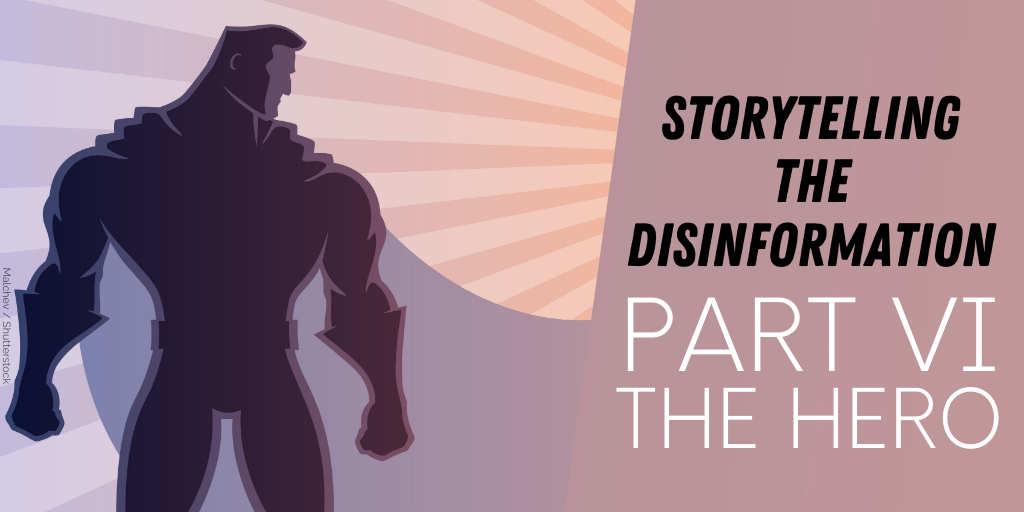
Saving the World
All good stories need a hero, and it goes without saying who the hero in the Kremlin fairy-tale is: yes, the Kremlin itself. While most European countries have stains on their pasts, Russia, as narrated by the Kremlin, never did wrong. The Kremlin’s pacts with Hitler were never pacts; Russia’s occupation of neighbouring countries were never occupations but in line with the international law of the past; Russia’s illegal annexation of Crimea and its aggression against Ukraine were expression of the will of local citizens or a response to US-sponsored colour revolutions.
Russia is, in this view, forced to repeatedly save the West from itself. The Kremlin’s top propagandist, Dmitri Kiselyov, explains Russia’s foreign policy altruism:
In Syria we are saving Europe for the fourth time. The first time was from the Mongols, the second time – from Napoleon, the third time – from Hitler, and now – from IS.
Russia’s role as a saviour is trumpeted on all political levels in Russia. President Putin conjures before his audience a gloomy picture of a world where Russia is battling against processes that threatens to plunge the world into chaos and darkness:
We know that more and more people of the world support our position on defending traditional values that have been the moral foundation of civilisation and nations: the values of the traditional family, the real human life; a life in religion, a life not only in materialism, but in spiritualism; the values of humanity and the differences of the world.
This is, of course, a conservative position. But, quoting Nikolay Berdyaev, the essence of conservatism is not to impede the progress forward and upward, but to impede the descent back and downwards into the chaotic darkness, into a return to a primitive existence.
Panicking Russophobes
During the coronavirus outbreak, Russia mobilised considerable resources to deliver assistance to countries that faced urgent shortages of medical supplies and staff. High-profiled missions to several European countries were organised and much-needed help was delivered. These missions were actively broadcast on all Kremlin-controlled channels, which went as far as to suggested that Russia was the only party offering help and assistance, which allegedly caused panic among russophobes.
The EUvsDisinfo Database of Disinformation contains several examples of this Russian exceptionalism: Russia managed to force NATO out of the Barents Sea (they didn’t); coronavirus did not spread in the former USSR (it did); the Russian language is changing the world (it’s not, really); Notre Dame belongs to Russia (no it doesn’t), as France has denounced Christianity (no it hasn’t).
Thus, our exposé of the Kremlin Storytelling is complete. The hero continues his valiant battle against dragons and evildoers everywhere. He will not rest until the villain is slain, the maiden is free and the sanctions regime is lifted.
Storytelling allows the disinformation operative to create a compelling story featuring a hero, a villain and a victim. The casting of the roles of villains and victims will depend on current affairs. The story can have a happy ending or a tragic outcome, but its core elements will essentially be the same.
For the Kremlin’s storytellers, the facts are irrelevant; the story is everything.




